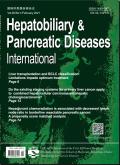胆囊癌早期诊断的进展和研究现状。
IF 4.4
3区 医学
Q2 GASTROENTEROLOGY & HEPATOLOGY
Hepatobiliary & Pancreatic Diseases International
Pub Date : 2024-10-04
DOI:10.1016/j.hbpd.2024.09.011
引用次数: 0
摘要
胆囊癌(GBC)是胆道系统中最常见的恶性肿瘤,具有恶性程度高、侵袭性强、预后差等特点。早期诊断对改善治疗效果至关重要。目前,GBC 的临床诊断主要依靠临床-放射学-病理学方法。然而,在临床实践中仍存在漏诊和误诊的可能。我们首先分析了基于血液的生物标志物,如癌胚抗原和碳水化合物抗原 19-9。随后,我们评估了各种成像模式的诊断性能,包括超声(US)、内窥镜超声(EUS)、计算机断层扫描(CT)、磁共振成像(MRI)、正电子发射断层扫描/计算机断层扫描(PET/CT)和病理检查,强调了它们在检测早期 GBC 方面的优势和局限性。此外,我们还探讨了新兴技术,特别是人工智能(AI)和液体活检技术在革新 GBC 诊断方面的潜力。人工智能算法已经证明了图像分析能力的提高,而液体活检则为无创和实时监测带来了希望。然而,要将这些进步转化为临床实践,还需要进一步的验证和标准化。综述强调了当前诊断方法的优势和局限性,并强调需要创新策略来提高 GBC 诊断的准确性。此外,我们还强调了多学科合作对于改善 GBC 早期诊断和最终患者预后的重要性。本综述旨在为 GBC 的早期诊断提供新的视角和见解。本文章由计算机程序翻译,如有差异,请以英文原文为准。
Advances and current research status of early diagnosis for gallbladder cancer
Gallbladder cancer (GBC) is the most common malignant tumor in the biliary system, characterized by high malignancy, aggressiveness, and poor prognosis. Early diagnosis holds paramount importance in ameliorating therapeutic outcomes. Presently, the clinical diagnosis of GBC primarily relies on clinical-radiological-pathological approach. However, there remains a potential for missed diagnosis and misdiagnose in the realm of clinical practice. We firstly analyzed the blood-based biomarkers, such as carcinoembryonic antigen and carbohydrate antigen 19–9. Subsequently, we evaluated the diagnostic performance of various imaging modalities, including ultrasound (US), endoscopic ultrasound (EUS), computed tomography (CT), magnetic resonance imaging (MRI), positron emission tomography/computed tomography (PET/CT) and pathological examination, emphasizing their strengths and limitations in detecting early-stage GBC. Furthermore, we explored the potential of emerging technologies, particularly artificial intelligence (AI) and liquid biopsy, to revolutionize GBC diagnosis. AI algorithms have demonstrated improved image analysis capabilities, while liquid biopsy offers the promise of non-invasive and real-time monitoring. However, the translation of these advancements into clinical practice necessitates further validation and standardization. The review highlighted the advantages and limitations of current diagnostic approaches and underscored the need for innovative strategies to enhance diagnostic accuracy of GBC. In addition, we emphasized the importance of multidisciplinary collaboration to improve early diagnosis of GBC and ultimately patient outcomes. This review endeavoured to impart fresh perspectives and insights into the early diagnosis of GBC.
求助全文
通过发布文献求助,成功后即可免费获取论文全文。
去求助
来源期刊
CiteScore
5.40
自引率
6.10%
发文量
152
审稿时长
3.0 months
期刊介绍:
Hepatobiliary & Pancreatic Diseases International (HBPD INT) (ISSN 1499-3872 / CN 33-1391/R) a bimonthly journal published by First Affiliated Hospital, Zhejiang University School of Medicine, China. It publishes peer-reviewed original papers, reviews and editorials concerned with clinical practice and research in the fields of hepatobiliary and pancreatic diseases. Papers cover the medical, surgical, radiological, pathological, biochemical, physiological and historical aspects of the subject areas under the headings Liver, Biliary, Pancreas, Transplantation, Research, Special Reports, Editorials, Review Articles, Brief Communications, Clinical Summary, Clinical Images and Case Reports. It also deals with the basic sciences and experimental work. The journal is abstracted and indexed in SCI-E, IM/MEDLINE, EMBASE/EM, CA, Scopus, ScienceDirect, etc.

 求助内容:
求助内容: 应助结果提醒方式:
应助结果提醒方式:


